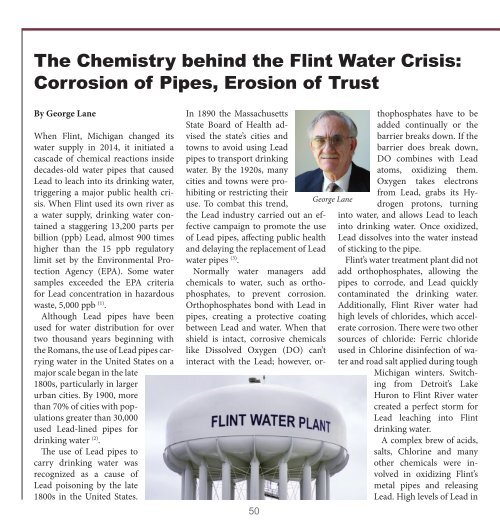Government Security News January 2017 Digital Edition
Government Security News January 2017 Digital Edition. Available on the GSN Magazine Website at www.gsnmagazine.com
Government Security News January 2017 Digital Edition. Available on the GSN Magazine Website at www.gsnmagazine.com
You also want an ePaper? Increase the reach of your titles
YUMPU automatically turns print PDFs into web optimized ePapers that Google loves.
The Chemistry behind the Flint Water Crisis:<br />
Corrosion of Pipes, Erosion of Trust<br />
By George Lane<br />
When Flint, Michigan changed its<br />
water supply in 2014, it initiated a<br />
cascade of chemical reactions inside<br />
decades-old water pipes that caused<br />
Lead to leach into its drinking water,<br />
triggering a major public health crisis.<br />
When Flint used its own river as<br />
a water supply, drinking water contained<br />
a staggering 13,200 parts per<br />
billion (ppb) Lead, almost 900 times<br />
higher than the 15 ppb regulatory<br />
limit set by the Environmental Protection<br />
Agency (EPA). Some water<br />
samples exceeded the EPA criteria<br />
for Lead concentration in hazardous<br />
waste, 5,000 ppb (1) .<br />
Although Lead pipes have been<br />
used for water distribution for over<br />
two thousand years beginning with<br />
the Romans, the use of Lead pipes carrying<br />
water in the United States on a<br />
major scale began in the late<br />
1800s, particularly in larger<br />
urban cities. By 1900, more<br />
than 70% of cities with populations<br />
greater than 30,000<br />
used Lead-lined pipes for<br />
drinking water (2) .<br />
The use of Lead pipes to<br />
carry drinking water was<br />
recognized as a cause of<br />
Lead poisoning by the late<br />
1800s in the United States.<br />
50<br />
George Lane<br />
In 1890 the Massachusetts<br />
State Board of Health advised<br />
the state’s cities and<br />
towns to avoid using Lead<br />
pipes to transport drinking<br />
water. By the 1920s, many<br />
cities and towns were prohibiting<br />
or restricting their<br />
use. To combat this trend,<br />
the Lead industry carried out an effective<br />
campaign to promote the use<br />
of Lead pipes, affecting public health<br />
and delaying the replacement of Lead<br />
water pipes (3) .<br />
Normally water managers add<br />
chemicals to water, such as orthophosphates,<br />
to prevent corrosion.<br />
Orthophosphates bond with Lead in<br />
pipes, creating a protective coating<br />
between Lead and water. When that<br />
shield is intact, corrosive chemicals<br />
like Dissolved Oxygen (DO) can’t<br />
interact with the Lead; however, orthophosphates<br />
have to be<br />
added continually or the<br />
barrier breaks down. If the<br />
barrier does break down,<br />
DO combines with Lead<br />
atoms, oxidizing them.<br />
Oxygen takes electrons<br />
from Lead, grabs its Hydrogen<br />
protons, turning<br />
into water, and allows Lead to leach<br />
into drinking water. Once oxidized,<br />
Lead dissolves into the water instead<br />
of sticking to the pipe.<br />
Flint’s water treatment plant did not<br />
add orthophosphates, allowing the<br />
pipes to corrode, and Lead quickly<br />
contaminated the drinking water.<br />
Additionally, Flint River water had<br />
high levels of chlorides, which accelerate<br />
corrosion. There were two other<br />
sources of chloride: Ferric chloride<br />
used in Chlorine disinfection of water<br />
and road salt applied during tough<br />
Michigan winters. Switching<br />
from Detroit’s Lake<br />
Huron to Flint River water<br />
created a perfect storm for<br />
Lead leaching into Flint<br />
drinking water.<br />
A complex brew of acids,<br />
salts, Chlorine and many<br />
other chemicals were involved<br />
in oxidizing Flint’s<br />
metal pipes and releasing<br />
Lead. High levels of Lead in















